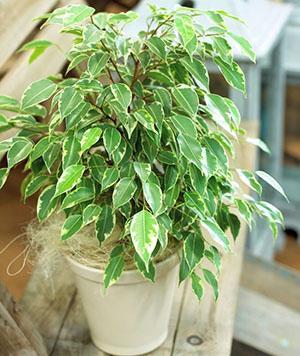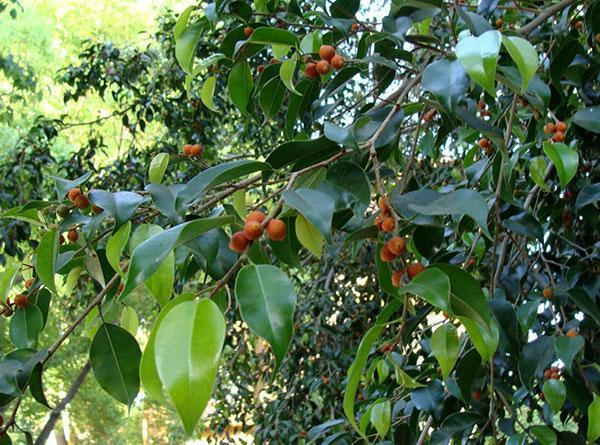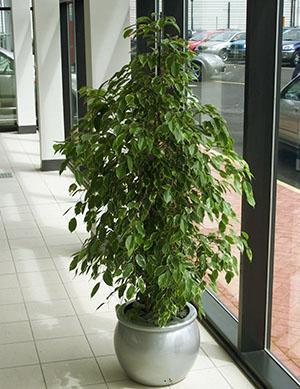Features of care, transplantation and formation of the crown of ficus Benjamin
 In the countries of the south and southeast of Asia, as well as in Australia, Benjamin's ficus is a common plant that can be found both in the wild and on city streets. Wild specimens grow to a height of 20 meters in tropics. Their indoor cousins are much shorter, but no less remarkable.
In the countries of the south and southeast of Asia, as well as in Australia, Benjamin's ficus is a common plant that can be found both in the wild and on city streets. Wild specimens grow to a height of 20 meters in tropics. Their indoor cousins are much shorter, but no less remarkable.
Ficus Benjamin are large bushes or trees with erect shoots and drooping, rather graceful branches, forming a spreading crown. Shoots are covered with smooth, pointed-elliptical leaves of uniform green or variegated color. The length of the leaf plate ranges from 6 to 12 cm. The central vein is depressed and well visible. On branches with grayish or light brown, smooth bark, the leaves sit alternately. Young foliage is thinner and lighter than mature foliage.
It may seem strange to many indoor plant lovers that their green pet is blooming and even bearing fruit. Like its closest relative, the fig, Benjamin's ficus forms more fruit-like flowers - syconia.
At home, this happens extremely rarely, but at home and when kept in greenhouses, after pollination on ficuses, rounded inedible fruits of a reddish-orange hue ripen.

- graceful foliage of green and variegated colors;
- the ability to get the most bizarre outlines of a tree or bush by shaping the crown of Benjamin's ficus;
- uncomplicated and easy care.
How to care for Benjamin's ficus
 Like all plants in the tropics, ficus Benjamin (photo) he loves warmth, is not indifferent to the high humidity of the air and soil, requires a long stay in the light, but at the same time he is afraid of direct rays and does not tolerate drafts.
Like all plants in the tropics, ficus Benjamin (photo) he loves warmth, is not indifferent to the high humidity of the air and soil, requires a long stay in the light, but at the same time he is afraid of direct rays and does not tolerate drafts.
As a rule, variegated varieties are slightly more moody than plants with green leaves. This is especially true for the illumination of the flower. If ordinary ficuses transfer content in partial shade, then for specimens with foliage decorated with a white border, spots or strokes, a little more set is needed, otherwise the contrasting patterns will fade and disappear.
An evergreen plant does not have a pronounced dormant period. Therefore, light, heat, water and food for ficus are provided all year round:
- In the warm season, from spring to late autumn, the plant is kept at a temperature of 22 to 28 ° C.
- In winter, the room where Benjamin's ficus is located can be 5-7 degrees cooler, but if the temperature drops below 14 ° C, the tree feels uncomfortable and may shed its foliage.
 In addition to long, but dim lighting and suitable temperature conditions, ficus high air humidity is required. No additional measures are required on summer days.
In addition to long, but dim lighting and suitable temperature conditions, ficus high air humidity is required. No additional measures are required on summer days.
You can only wash the crown with a warm shower and water the soil in a timely manner. But in winter, with the heating appliances working, it is useful for Benjamin's ficus to turn on an electric humidifier or irrigate the foliage from a spray bottle every day.
Watering and feeding ficus Benjamin
 Ficus does not tolerate drought, reacting to dryness of the soil with yellowing and falling leaves. In summer days the plant watered often and abundantly so that the soil surface almost dries up between waterings. It is important to avoid stagnant moisture.Its surplus, flowing into the pallet, must be removed after half an hour. If this is not done, even in summer you can face manifestations of root rot.
Ficus does not tolerate drought, reacting to dryness of the soil with yellowing and falling leaves. In summer days the plant watered often and abundantly so that the soil surface almost dries up between waterings. It is important to avoid stagnant moisture.Its surplus, flowing into the pallet, must be removed after half an hour. If this is not done, even in summer you can face manifestations of root rot.
In the cold season or when keeping the flower in a cool room, the frequency of watering is slightly reduced. It is often enough to water the soil under Benjamin's ficus just once a week to maintain the normal well-being of the pet.
Asking the question: "How to care for Benjamin's ficus?" many novice flower growers forget about such an important stage of care as feeding. Ficus grows rather quickly, and in order to maintain the formation of the crown and the juiciness of the leaves, it needs not only moisture, but also the whole complex of nutrients and trace elements.
Therefore, from spring to early autumn, the care of Benjamin's ficus, in the photo, at home, must include regular feeding. It is best to use liquid complex products for decorative deciduous crops. Fertilizers are applied at intervals of two weeks.
Ficus Benjamin transplant at home
 Looking at how his pet grows and prettier, a lover of indoor plants should not forget that not only branches and leaves are added. Month after month, ficus increases the volume of the root system, and the soil, even with constant feeding, gradually becomes scarce.
Looking at how his pet grows and prettier, a lover of indoor plants should not forget that not only branches and leaves are added. Month after month, ficus increases the volume of the root system, and the soil, even with constant feeding, gradually becomes scarce.
The Benjamin ficus transplant will help to correct the situation; it is carried out at home in the spring, and young specimens have to be transferred more often into new pots than adults.
A sign that the roots are completely entwined with earthen food can be considered their appearance from the drainage hole or the subsidence of the topsoil. But it is better not to allow this and carry out a planned transplant, preventing a "half-starved" existence harmful to the plant.
Before transplanting Benjamin's ficus into another pot, you still need to choose a suitable container. The younger the specimen, the more actively it builds up the root mass. Therefore, such plants are annually transferred into pots, the diameter of which is 2–3 cm larger than before. For adult ficuses, the transplant is required 2-3 times less often, and if the green pet has reached a solid size, then the transplant can be replaced by replacing the upper layer of the substrate.
The best soil for Benjamin ficus is specialized, ready-made. But if desired, at home, you can make a mixture of equal parts of turf and leafy land, bottom peat and sand.
Ficus Benjamin: crown formation and regular pruning
 Young shoots of Benjamin ficus are distinguished by a high growth rate and are very flexible. The first circumstance obliges the owner of the flower to master regular pruning. It is performed in the spring, when the plant is just awakening to growth. In the summer, a pinch of rapidly growing shoots out of the general rhythm is carried out. At the end of the growing season, in the fall, it is not worth subjecting Benjamin's ficus to crown formation. All the substances in the foliage and shoots will be useful to him during the winter.
Young shoots of Benjamin ficus are distinguished by a high growth rate and are very flexible. The first circumstance obliges the owner of the flower to master regular pruning. It is performed in the spring, when the plant is just awakening to growth. In the summer, a pinch of rapidly growing shoots out of the general rhythm is carried out. At the end of the growing season, in the fall, it is not worth subjecting Benjamin's ficus to crown formation. All the substances in the foliage and shoots will be useful to him during the winter.
The culture easily tolerates pruning, so there is no need to be afraid of a radical change in the appearance of the plant while it is young. It will be much more difficult to form a crown for a ficus when it turns into a shapeless giant.
In the spring, they not only remove dried and shorten excessively elongated branches, but also cut off the branches directed into the crown. If this is not done, they will obstruct the penetration of air, thereby increasing the risk of developing fungal infections and settling pests. For the same purpose, large cuts of branches are treated with garden varnish or their activated carbon powder.
A video about pruning Benjamin ficus at home will tell you in detail how to perform this difficult procedure and achieve uniform growth of branches throughout the growing season.
Diy Benjamin Ficus Bonsai
 Most often, Benjamin's ficus is shaped into a tree when grown.If there is support, the plant easily gets used to the standard form, and pruning the lateral and basal shoots helps to maintain it. But today you can see quite unusual trees based on ficus with openwork, wicker trunks.
Most often, Benjamin's ficus is shaped into a tree when grown.If there is support, the plant easily gets used to the standard form, and pruning the lateral and basal shoots helps to maintain it. But today you can see quite unusual trees based on ficus with openwork, wicker trunks.
At first glance, an incredibly complex structure can be recreated at home. To do this, several young plants of the same age are planted in one pot and their flexible stems are intertwined in any way they like. It is important that the weaving is not too tight and does not prevent the ficuses from developing evenly. In this case, after a few years, the trunks grow together, turning into an original green decoration of the house.
 Florists with patience and the skills to form woody plants can grow Benjamin ficus bonsai with their own hands. With the help of weaving, obtaining air layers and pruning, an ordinary bush turns into a miniature copy of a century-old banyan tree.
Florists with patience and the skills to form woody plants can grow Benjamin ficus bonsai with their own hands. With the help of weaving, obtaining air layers and pruning, an ordinary bush turns into a miniature copy of a century-old banyan tree.
Ficus Benjamin: signs and superstitions
There are a lot of legends and superstitions about many indoor plants, especially those that fall into the collections of flower growers from remote corners of the planet. Some of them can be believed, but most of these signs are idle inventions.
What are the signs about Benjamin's ficus, and can this ornamental plant be kept at home?
 In the century before last, a person who wants to acquire a ficus was warned that the plant contributes to family quarrels, life's troubles and can even attract death. The same or similar warning followed upon purchase monsters and other aroid plants.
In the century before last, a person who wants to acquire a ficus was warned that the plant contributes to family quarrels, life's troubles and can even attract death. The same or similar warning followed upon purchase monsters and other aroid plants.
Back in the 20s and 30s of the last century, the owner of a ficus tree would have been suspected of adherence to a bourgeois lifestyle, which caused a lot of trouble. Today there is no place for such absurd inventions. And the unpretentious, fast-growing and very attractive ficus of Benjamin can be seen in residential and office buildings around the world.
 All the stories that reveal the plant from the negative side have no real ground under them. But in the homeland of the ficus Benjamin, he is very revered.
All the stories that reveal the plant from the negative side have no real ground under them. But in the homeland of the ficus Benjamin, he is very revered.
In China, it is a wonderful gift, symbolizing the wish for longevity, health and all kinds of well-being. In Thailand, the plant is recognized as the official symbol of the country's capital. A 150-year-old bizarre ficus in Sri Lanka is considered one of the local attractions and is visited by many tourists.
Modern superstitions and signs about Benjamin's ficus also have a positive attitude. For example, it is considered a good omen to bring a plant to the house where they dream of having a child. If the flower takes root and grows well, then the married couple will soon have an heir.
Hello. I want to transplant ficus into a larger pot in the spring and prune, can these procedures be done at the same time or do I need an interval between them and what should be done first of all transplanting or pruning?
There must be a break of at least a couple of weeks between transplanting and pruning, so that the ficus acclimatizes to a new place and takes root in fresh soil. But you can do differently: carry out pruning now, when the growth processes of flowers freeze. And then the transplant can be done in the spring.
Thanks Olga!